Sustainable SEO strategies to avoid greenwashing
According to research, two-thirds of consumers are likely to pay more for a sustainable product.
Integrating and communicating the brand values of sustainability is integral to eCommerce strategy — but how can you achieve this without greenwashing?
It might be appealing for companies to dump a bunch of ‘green’ terms into their pages and hope for the best, but customers (and Google) won’t be so easily fooled.
We’re now hyperaware and critical of companies claiming their product is ethical and environmentally friendly, so choosing the best and most correct presentation methods is crucial.
These tips apply to brands both within and outside of the sustainability industry. Having a green agenda and goals is something most organisations now adopt. Understanding how to communicate this with consumers helps elevate your brand and inserts you into a growing category of sustainable merchants.
Let’s look at some sustainable SEO strategies you can incorporate into your eCommerce marketing plans to help relay brand values and avoid greenwashing.
Category pages
A product’s sustainability is a critical factor in the decision-making process of eco-conscious consumers, so communicating this early and effectively is essential.
Product category pages offer an excellent opportunity for brands to give an overview of their items, highlighting materials and processes.
Alongside traditional categories, brands can allow customers to browse by fabric, production method, or any other sustainable attributes. This is particularly effective for sustainable clothing company websites.
In the following example, eco-clothing brand Thought has split its clothing into several sustainable fabric collections. Customers can navigate and filter their options by product type, size, colour, and more.
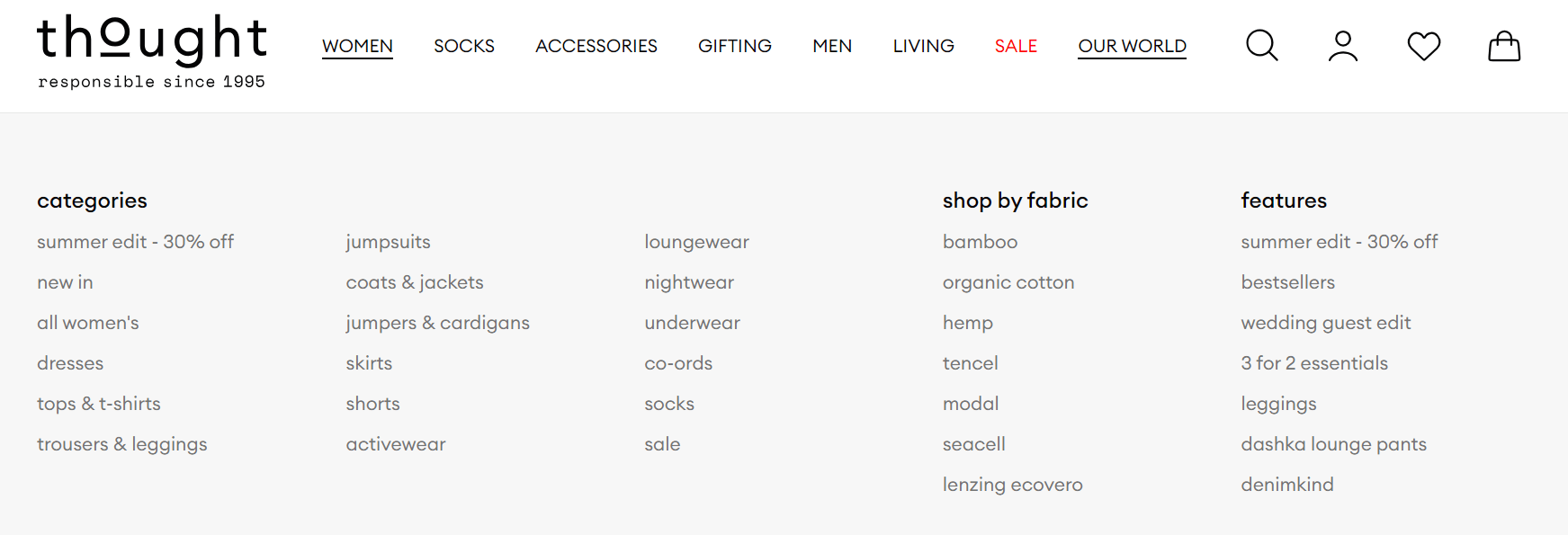
This approach works for a few reasons. First, it allows the brand to target green terms through metadata and naturally in the copy without keyword stuffing. By dedicating a page each to hemp, organic cotton, linen, etc., the category description can explain the material or link to further subcategories, as Thought has done here:
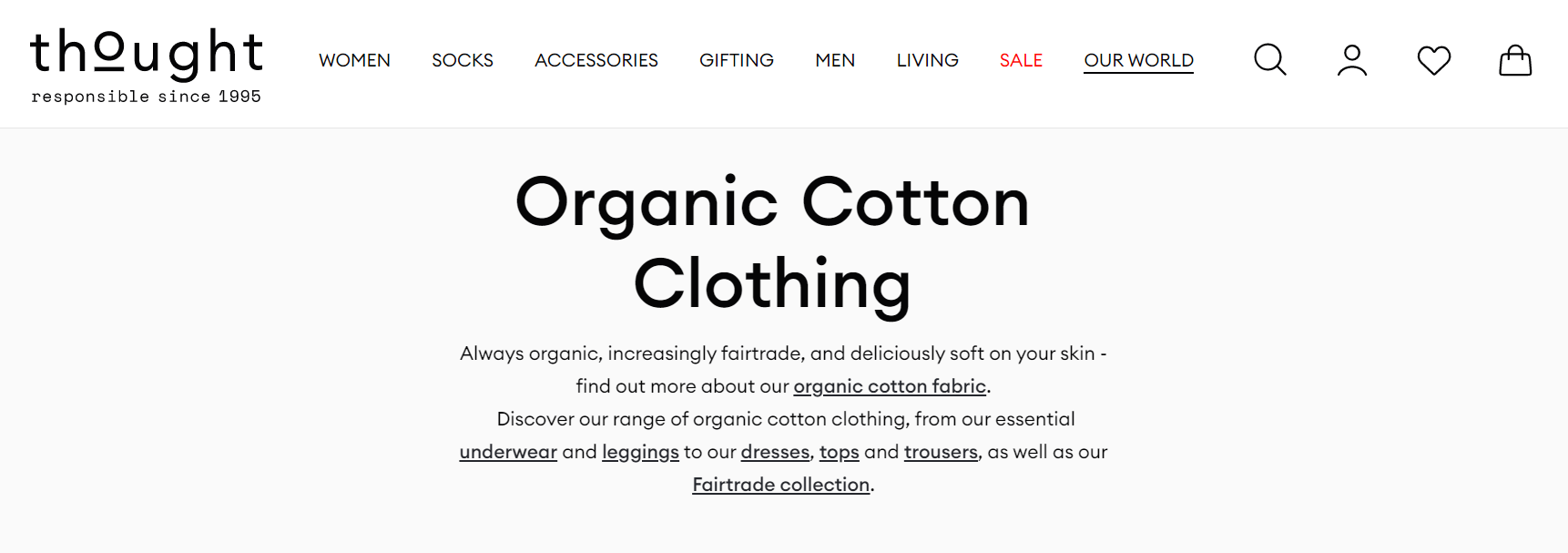
Next, it demonstrates brand awareness and expertise to the customer. This brand has researched its product materials and wants consumers to know using more sustainable items is vital to their values. In other words, its ‘organic cotton collection’ isn’t buried or hard to find, which is also good for site navigation.
Highlighting production methods or unique collaborations is another category direction eCommerce brands can take.

Here, People Tree has selected a few areas to draw attention to, including its handcrafted items and vegan clothing.
This satisfies several transactional search terms and enables a different way for mindful customers to navigate the site.
The page copy allows the brand to highlight any sustainable certifications — in People Tree’s case, Fair Trade Certified or PETA-Approved Vegan. It’s also a chance to weave storytelling into its products, as People Tree has done on its handcrafted page:
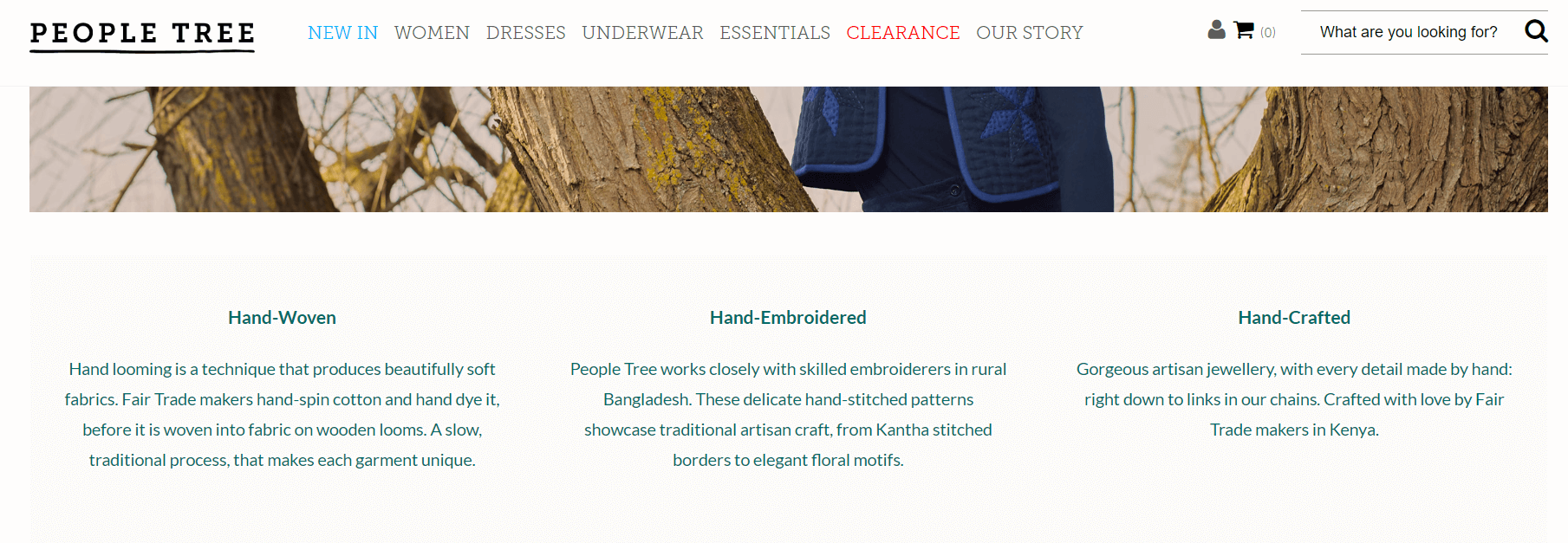
We’re given insight into the brand’s ethical production methods and value propositions, adding to the company’s transparency and trustworthiness.
Other subcategories that eCommerce sites may want to consider are limited collection, partnership, or collaboration pages.
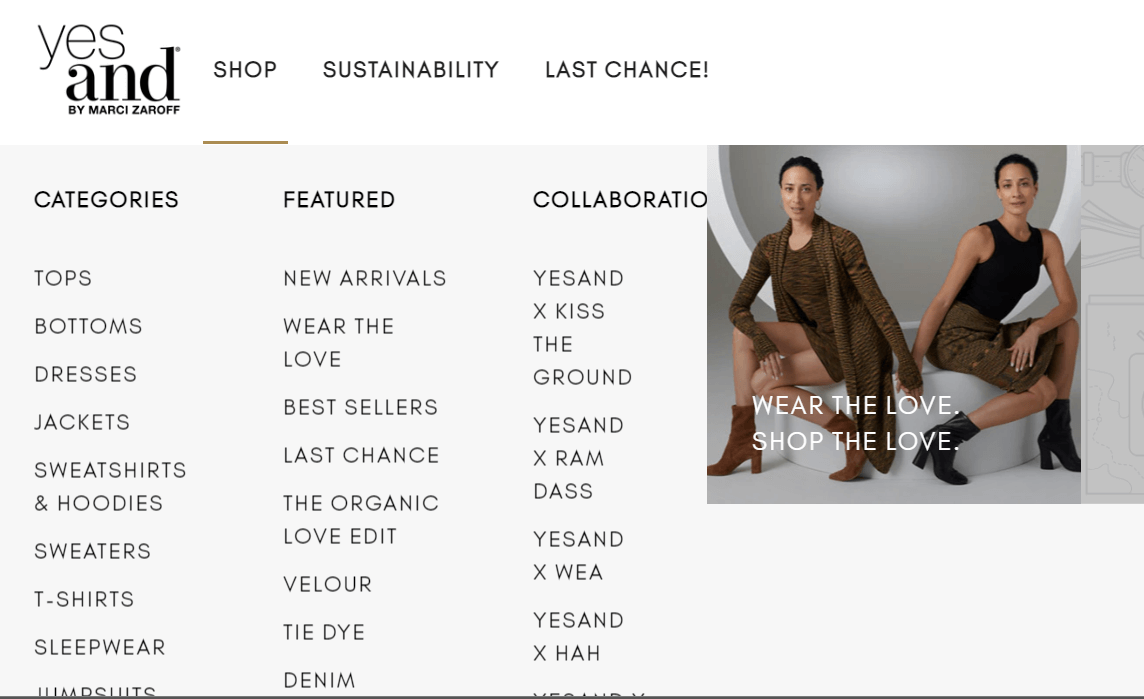
In this example, sustainable clothing brand YesAnd has a category and subcategories for its collaborations.
The partnerships represent the company’s fashion innovation, social justice, and environmental responsibility values. The page copy is enriched with information on the limited product line, allowing the brand to communicate its sustainability commitments.
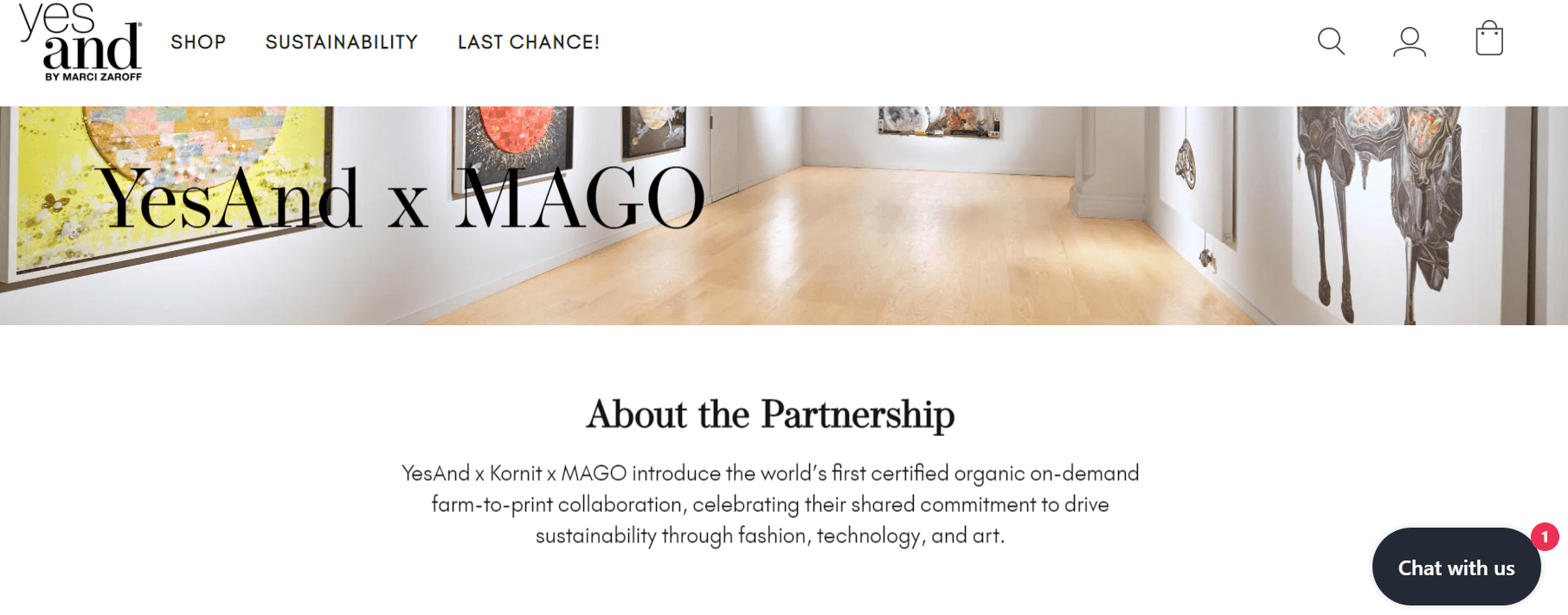
This appeals to consumers and targets other businesses for potential future collaborations. It’s also a good linking strategy and another chance to embed storytelling into the category pages.
Product pages
It’s essential to continue your sustainable SEO strategy, even once consumers have navigated through your category pages and landed on a product.
However, there’s a fine line between being informative and greenwashing an item.
Most eco-conscious shoppers will know their green terms, and those that don’t won’t appreciate being misled. Selecting the best way to describe your product is challenging yet important. You want to target specific terms but don’t want to engage in greenwashing to any degree.
The safest approach here is honesty — don’t label your product as 100% recyclable or biodegradable if it isn’t. Major fashion brands have been criticised for advertising their clothes as made from sustainable or recycled materials, which turns out to be exaggerated or false. These errors (intentional or not) are quickly spotted and shared — a PR scandal your eCommerce company doesn’t need.
Choose terms that correctly describe a product and elaborate when things need more information. Consumers will value honesty, and it’s a chance to discuss your sustainability goals, such as if you have plans to use 100% organic linen by 2025.
Pairing these green phrases with relevant products and services is also important. For example, ‘sustainable clothes’ is usually too generalised for product pages and is a competitive term. It can be more beneficial to use long-tail keywords like ‘organic cotton dress’ or ‘vegan gym trainers’ in these sections instead. You’ll target a more relevant search intent and demonstrate unique value proposition.
Where you can, back up your claims with supporting evidence, such as certifications and awards. It’s good to implement imagery, too — most shoppers will immediately recognise the Fair Trade-certified or Leaping Bunny logos.
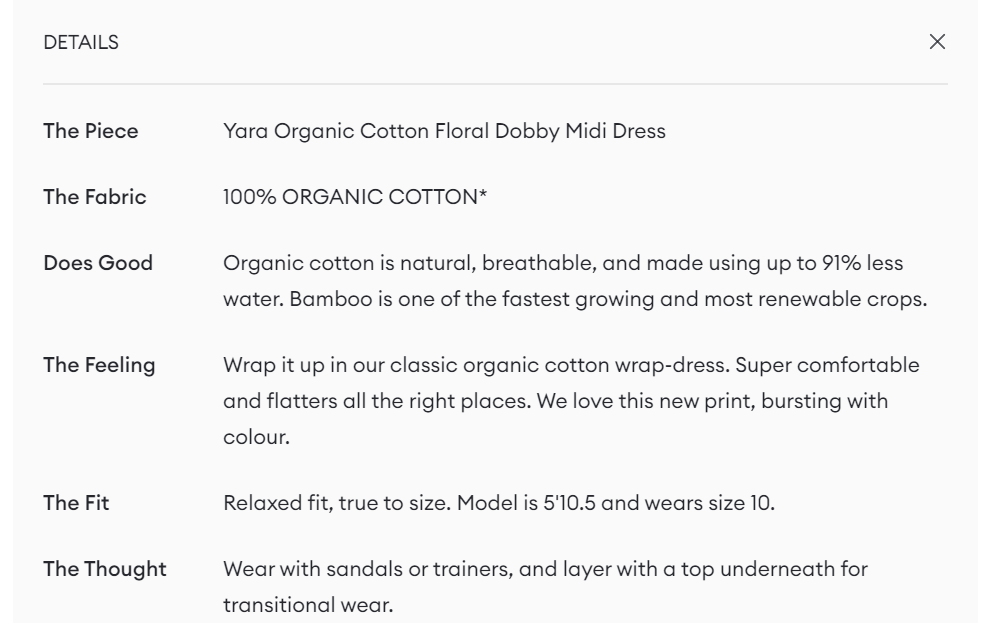
This product description layout from Thought is an effective way to highlight the materials and reiterate why the item appeals to sustainable shoppers.
There’s also a missed opportunity here to link those previously mentioned fabrics category pages or supporting blog content.
New technologies also allow brands to demonstrate even more transparency on their product pages, such as using CO2 calculators to share the environmental impact of each item. This encourages customers to make informed purchasing decisions and lets brands discuss their carbon reduction efforts.
Enriching product pages with sustainability information, relevant green terms, and widgets provides consumers with a great shopping experience and demonstrates brand values of sustainability.
How to communicate sustainability brand values through supporting content
Outside the category and product pages, you should use other areas of your eCommerce site to communicate your brand’s sustainability values.
Blogs are a fantastic way to highlight your sustainable approach and industry expertise, while origin pages help give your store a human face and share ‘green’ founders stories.
Many eCommerce brands — eco-focused or otherwise — have also adopted sustainability reports, integrated directly into the website or available for download.
If you don’t have the resources for an annual report, it’s still worth mentioning long-term sustainable goals and achievements and having a separate site page. It’s also an excellent place to mention certifications and shows the consumer the broader impact of your sustainable product.
Other sustainable content sections to consider are:
- production methods – containing information on eco-friendly and ethical manufacturing methods
- the brand’s approach to diversity, equity, and inclusion (DEI)
- materials – with information on all the materials used, including packaging
- impact – an opportunity for the brand to acknowledge its environmental impact, usually concerned with carbon emissions, waste, and land and water usage
- social responsibility – details of charitable foundations, volunteering, partnerships, etc.
Being informative and transparent is an effective way to build customer loyalty and avoid greenwashing accusations. Sharing sustainable brand values responsibly helps demonstrate a genuine commitment, amplifies the message, and ensures your brand reaches a broader, more conscious audience.